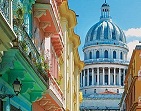About Cuba
Cuba is a multiracial country. The Cuban scholar Fernando Ortiz called our nation a stew (Creole stew which involved many products): Indian, African, Spanish, and to a lesser extent English, American, Chinese or French …
From the way they dress, dance, create, speak and even lead the life, Cubans are very peculiar. They always have the oportune joke or the sedative smile, even in moments of greatest tension. Passionate, responsible, outgoing, hardworking, sports and music lover, dancers, attached to their traditions, Cubans are said to be unique.
For Cubans, their country is their child, mother, father, lover, obsession and wakefulness. Cuba is spell in dew mornings and veins warmth in nights of love. It’s coffee, rum, snuff, dance, playing baseball. It is, as the poet said, retracing passion, but above all, patriot, lover and defender of his own.
Say Cuba and talk will go around exclusivity and the uniqueness of those filling the island with poems and stories, lineage of universal generations bearing children who, over five and more centuries, have written stories, told or not, but inclusive of those seven letters that distinguish us: Cubans.
Currency:
Cuba’s national currency is the Peso (CUP), which equals 100 cents. Notes can be of 1, 3, 5, 10, 20, 50, 100, 200 and 500 pesos, and fractional coins of 1 and 3 pesos, and 1, 2, 5 and 20 cents. The Cuban Convertible Peso (CUC), used as an exchange medium of foreign currencies at officially established exchange rates also circulates. The CUC is not valid or changeable outside Cuba. If still possessing some when leaving the country, you can exchange them at the airport for U.S. dollars or other internationally used currency. Tourists most used currency is the CUC, to afford all products and services available in the country. However, some items may be purchased at CUP. The foreign exchange convertible pesos (CUC) is performed at airports, banks, hotels, currency exchange offices and great shopping. Credit cards are accepted when supported by: Transcard, Visa, MasterCard International, Access, International Bancomer, Eurocard, Banamex, Diners Club International, JCB and Carnet, provided they have not been issued by U.S. banks or their subsidiaries, as well as means of payment for national use issued by the International Financial Bank (BFI cards), and by the banks of Credit and Commerce, Metropolitan, Popular de Ahorro (Saving Popular Bank) and BICSA (RED cards).
Clothing to visit Cuba:
Light color cotton or similar fabric clothing are best suited for most of the year. However, from late October to March, cold fronts are frequent with casual recorded temperatures of minus 10 degrees Celsius (40 degrees Fahrenheit). For this time of year is good to have a light wool or gabardine coat.
In the rainy season (May to October) it is advisable to have a light raincoat.
Casual wear (jeans, shorts, shirts, sandals, tennis or light and fresh shoes) are used for almost all locations. However, more formal attire is called for to attend theaters, fancy restaurants, concert halls and other, for which we recommend long-sleeved shirt and tie, without ruling out the use of suits.
Customs Regulations:
Customs Declaration
Visitors enjoy the benefits listed in the Convention on Customs Facilities for Tourism, of which Cuba is a signatory. Besides clothing and other items -either new or used- reasonably required for personal use, , any of the following items will be also considered as personal effects (exempt from duties), provided that they can be estimated as in use, and that they are re-exported when leaving the country, as these items are supported as temporary importation.
These items include personal jewelry, a camera with twelve plates or five film rols, a small milimeter film camera with two film rolls, a pair of binoculars; portable music instrument, a portable gramophone with ten albums; a portable sound recording, a portable radio receiver, a portable television receiver, a portable typewriter, a pram, a tent and camping equipment, sporting goods (a set of accoutrements for fishing, a bike without a motor, a canoe or kayak less than 5.50 meters long, a pair of skis, two tennis rackets, and other similar items), a video camera, a microcomputer staff, Portable DVD device; personal portable devices that allow to draw or enter information on personal computers, such as flash memory, MP3, MP4, IPOD, Agenda book, PALM and similar.
Previous facilities and exemptions may not be granted in cases of tourists who come to Cuba more than once a month, or to people less than ten years old.
Legal procedures
To travel to Cuba for pleasure or recreation, visitors should adjust their trip to a tourism program contracted with international agencies in agreement with the Cuban Ministry of Tourism (MINTUR) and submit their visa application through the tourist agency responsible for the trip. The Cuban consulates at your residence country embassy, or the Cuban representations where there were no embassy, can be contacted too.
To travel to Cuba it is required a passport valid for at least six months, and a tourist card or VISA. The Tourist Card is automatically issued with the purchase of tourist services (tickets, for example) at any authorized travel agency, or, as it goes with the VISA, in a Cuban consulate, applying and paying the appropriate fee.
Business trips, extended or work stays, require special visas, so you should contact the Cuban consulates or embassies.
